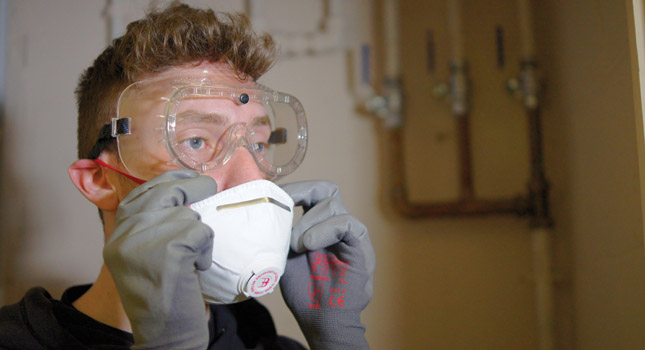

Personal protective equipment is often overlooked because it is perceived too cumbersome for day-to-day tasks, which can leave professionals exposed to risks. Paul Burnett looks at the equipment that best ensures plumbers’ health & safety.
As defined in the Personal Protective Equipment at Work Regulations 1992, Personal Protective Equipment (PPE) covers “all equipment (including clothing affording protection against the weather) which is intended to be worn or held by a person at work which protects them against one or more risks to their health and safety”.
With that in mind, PPE is a must for all occupations where there is a level of personal risk involved. Plumbers and heating engineers, for example, will face a multitude of working conditions that could put their own health and safety at risk unless the appropriate PPE is worn.
A host of dangers
When cutting or grinding pipes, where there is a risk of copper or plastic shards flying into the air, eye protection should always be worn – particularly since it is reported that there are over 1,000 eye accidents recorded on site every year. Even if the installer wears glasses, over-spectacle protection is available to help protect the sides, where eyes can still be vulnerable if not covered appropriately.
In certain situations, ear defenders may also be required. For example, using a large hammer drill to bore a hole through an external wall for an overflow pipe would require the use of ear protection, either in the form of expandable ear plugs or ‘over head’ ear defenders – whichever the installer finds more comfortable.
Where there is a risk of potential exposure to hazardous substances, like sulphur dioxide, asbestos, mould, solvent, solder or other toxic or carcinogenic substances, appropriate respiratory protective equipment should be worn. This is particularly so when working on or replacing elements in a very old plumbing and heating system, as pre-1970’s properties may contain lead pipes.
Respiratory protective equipment includes face masks, hoods and helmets – of course not all elements are needed at all times so it is important to understand the level of risk involved when working with certain substances. If in doubt, it is always worth checking before carrying out any work.
Handling heat
When working with copper pipes and solder, there is a great deal of risk involved due to the use of a naked flame. Not only does the flame itself pose a very real risk, but pipes can also quickly become extremely hot to the touch.
While it may seem obvious, appropriate safety gloves that provide a good level of protection against heat must always be worn, in order to adequately protect the hands and wrists. It may also be worth investing in a heat resistant sleeve, which can be worn in addition to gloves, for use when working in tight spaces where the risk is increased.
Generally speaking, safety gloves are often considered to be cumbersome, making delicate tasks hard to perform. This is simply not the case; there are gloves available which provide a very close fit and offer excellent protection against heat transfer and cut protection – another aspect that is well worth bearing in mind when handling pipes or equipment with sharp ends that could puncture the glove.
Crucial kit
PPE should always be considered part and parcel of any installer’s day to day kit.Just as the van will always be stocked with parts and spares needed to carry out a job, full PPE including gloves, face mask, eye and ear protection should be close at hand too.
What’s more, such equipment is readily available in most instances from a merchant, found alongside boilers, heating spares, pipes and tools.
Paul Burnett is category manager for Graham Plumbers’ Merchant
If you'd like to keep up-to-date with the latest developments in the heating and plumbing industry, why not subscribe to our weekly newsletters? Just click the button below and you can ensure all the latest industry news and new product information lands in your inbox every week.